0. What is this post about?
Buying a stock at the right price is equally important as choosing which stock to invest in. There are many ways to find the right valuation of a stock. There is the well known academic way of Discounted Cash Flow (DCF). Then there are momentum indicators such as MACD, RSI indexes. One may choose to do these technical calculations at their end. One can also opt for a premium stock screener websites/apps to get right valuations of a stock. Some investors even rely on social media influencers to decide which price to invest in. Others follow price targets and buy/sell recommendations given by popular stock broker houses such as Motilal Oswal, ICICI Securities, HDFC securities. Do note that these broker house recommendations are not always free.
What if I told you that there is a free, two minute rule, to find the right price to buy a stock? Yes, there is. And that is what I will discuss in this post. This two minute rule will help you in most of the cases to make an investment decision. I will cover why this rule works, what are the exception cases, and how you can start applying this rule. No technical analysis, no paid premiums, no prior investment experience. Just a plain vanilla rule that any retail investor can use. Let’s get started.
1. Why is the buy price of a stock important?
Almost every tenured investor advises to always buy a stock at a discounted price. Value investor guru Benjamin Graham’s ‘Margin of Safety’ concept revolves around the same concept. Why is buying at the right price so important? Let’s find out.

1.1 Maximize Gains
Buy low, sell high. This has been the money making mantra for ages. And it still holds true in the world of the stock market. Buying a good company at low price ensures you will make the most of the upside. Do note that the stock price will go up only if the fundamentals of the company are strong, and its future growth story is intact.
What if you buy high? Well, if you buy high, then you will make low gains, or may even see losses. An overpriced stock can correct over time. This can be driven by PE (Price to Earning ratio) downrating, or by stagnant price as valuation multiple catches up to historical averages.
Do note that there can be an exception to this rule in momentum style investing. In momentum investing, you buy high and sell higher. However, momentum investing ensures that the price upward momentum will continue in a stock for some time. Therefore you will make some gains from buying high, and selling higher. In this post, I will skip discussing momentum investing, and only focus on buying good companies at the right price.
1.2 Less Stress
Who wouldn’t want to invest right, and then relax, and see your stock portfolio turn greener by the day. Stock market volatility causes stress. This stress leads to panic selling, and hopeful buying. To avoid this, invest at the right price, and then sit back, and enjoy the ride as the stock moves up. The stock price will not linearly go up, but it will relatively go up over time.
If you buy at a high price, you will be worried as stock price moves down during market correction. You will start questioning your investment decision, and even the quality of the company behind the stock. The best way to hate a good company, is by investing in it at a high price, and then seeing your investment erode over time. To avoid this, keep calm and invest at the right price.
1.3 Less wait period to profitability
Two things can happen when you invest at the right or low price. In the first scenario, the stock price can go down further, as the market bottoms out. In the first scenario, there will be short term pain, as the market reaches bottom, stays there, and then starts going up. The first scenario can also be caused by temporary headwinds faced by the company. These headwinds can stall its near term revenue growth or operating margin. As these headwinds go away, the stock price will start rising in the medium to long term. To summarize, in the first scenario, there is one to two quarters of pain. After this painful period you will start seeing good gains.
In the second scenario, the stock price starts going up, and gives you profit right away. We see that in both the scenarios, you will start seeing profits within 1-2 quarters. These profits will sustain in the long term, as the stock price undergoes volatility and keeps rising up overall in the long term.
However, if you had invested at a high price, at a higher valuation, you would have to wait much longer before seeing profits. You might even have to wait a couple of years till the company’s earnings catch up to the earnings multiple the stock price is getting in the market. If the high stock price was driven by euphoria in the market, then the losses may widen and stay that way for multiple years to come. A worse scenario is when you invest at a high price during a company’s upcycle. After an upcycle comes a down cycle which can last as long as four years. This means you will only see your losses increasing for the next four years, as you wait out the downcycle to get over. Not a good situation to be in.
2. Why is investing at a low price difficult?
If investing at a low price with a margin of safety was easy, everyone would be doing it. But that is not the case. Investing at a low price is difficult, and here is why.
2.1 Fear Of Missing Out (FOMO)
Fear of missing out drives investors to invest in a stock at whatever price available. Driven by analyst recommendations, or by social media influencers who paint a rosy picture of a stock doubling in six months, investors flock to invest in the stock. FOMO investing throws logic out of the window, and investors buy at whatever price the stock is available at. Well, we all know that always does not work out. FOMO investing can drive the stock price up in the short term. But in most cases, price always corrects to match the earnings growth potential of the underlying company.
2.2 Saying No to Investing in a Good Company
You, as a retail investor, have done a ton of research to identify a great company. The future of this company looks bright. However, the price is overvalued, and is available at a high price. You do not want your research to go to waste. What do you do? You buy. Well, not so fast. Buying a good company at a high price is not the right way to generate returns in the stock market.
Saying no is usually hard, even in our personal and professional life. But to make gains, you have to say no if the investment criteria, which includes buying at the right price, is not met. In the investing world, one should not fall in love with a company, but only love their investment strategy.
2.3 Expensive Things are of Better Quality
People relate high prices with better quality. This general idea also influences investing decisions. This leads to the exact opposite of buy low and sell high. High price can indicate a good quality company, but does not indicate a good investment opportunity. Investment decisions should be made devoid of emotions and biases. Buying good companies at a fair price is the way to go.
2.4 Waiting is painful
Waiting for the right price of a company stock is painful. Patience is a virtue not commonly found. If you take a horizon of two years, there is bound to be some changes in macroeconomics caused by political instability, regulatory reforms, supply or demand side constraints. These headwinds cause short term dips in prices of good quality companies. However, one needs to be patient to make the most of these opportunities. Patiently build your war chest (cash), and wait for the right time to buy. The right time to buy will definitely come, what is harder is for you to patiently wait for these times.
3. The Golden Rule of Investing at the right price
Here it is. I will tell you the Golden Rule, and then explain how it works, and how to apply it with some examples.
The Golden Rule: “Buy if the Current Market Price (CMP) of a stock is lower than its 200 Day Moving Average (200 DMA) price, and its current Price to Earnings multiple (PE) is lower than or equal to historical 5 year median PE.”
3.1 Decoding the golden rule of investing at the right price work?
The golden rule of picking the right price for investing in a stock has two components.
Part 1: CMP less than 200 DMA
This part ensures that the current price of the stock is low, and is less than historical 200 days moving average price of the stock. This is a downward momentum indicator, meaning the stock is going out of favor with the investors. This can be driven by visible headwinds, margin compression, unfavorable news around the company etc.
Part 2: Current PE less than historical 5 year medium PE
This ensures that the valuation of the stock is fair or at a discount. If the current PE is higher than historical media PE, the stock is overvalued, or the overall market sentiment is in euphoria, and a correction is imminent.
3.2 Why does the golden rule of investing at the right price work?
The golden rule of picking a stock at the right price works most of the time. And here is why.
Reason 1: Supports Buy Low, Sell High strategy
Buy low and sell high is the age old formula of making money. The golden rule supports this. The rule helps you identify stocks which are trading at lower than fair price, or in other terms, are trading at a discount.
Reason 2: Identifies Greed and Fear Sentiment
Stock market’s mood is like a pendulum. It swings between the extreme ends of Greed and Fear. At the end of Greed, the market is overvalued, and stocks are available at pricey valuation – a bad investment point. At the other end is Fear, where the market is undervalued, and stocks are available at a discount – a great investment point. Using the golden rule, you can avoid time periods when the market is in the Greed zone, and invest when the market enters the Fear zone.
Reason 3: Removes Emotion from Investing
Investing is hard because investment decisions are easily influenced by emotions. One may sell in panic and buy in hope of making profits overnight. However, if you follow a rule to make investment decisions, and stick to these rules, then it takes the emotion out of the decision making process.
Reason 4: Uses Historical Price Movements to determine valuation
Stock price is influenced by various factors. News, rumors, market sentiment, management’s commentary, earnings growth, regulations etc. Due to these influences, the stock price goes up and down. The stock price changes may not reflect the underlying value of the company, and this creates buy and sell opportunities.
However, this volatility is averaged out over a longer duration. As investment guru Benjamin Graham says: “In the short run, the market is a voting machine, but in the long run it is a weighing machine”. Hence, using the past 200 days average stock price, and the past 5 years median PE gives us the fair price and valuation of a stock price. When we compare these historical indicators with current values, it tells us the state of volatility the stock price is in, and whether this state is a Buy or a Sell scenario.
3.3 Pre-requisites for applying the golden rule
Below are some prerequisites to applying this golden rule for picking the right stock price to invest. The broad idea here is to first identify a good company to invest in. And then apply the golden rule to find the right price to invest in.
3.3.1 Sunrise Sector
The company should be working in a sunrise sector, with good future growth potential. This ensures that the company will be able to generate higher revenues in the coming years. Conversely, if the company is in a sunset sector such as Oil & Petroleum – then the company will face headwinds, and will struggle to generate profits for its investors.
3.3.2 Good Management
A decent company working in a growth sector needs good management to run the business and deliver future vision of the company. One should study the top management of the company. Investors should look for management qualities such as: (a) Having skin in the game (high promoter holding), (b) Walking the talk (delivering what they promise in quarterly earnings calls or annual general meetings). Some red flags one should check for is any previous fraud related news, or investigations on the management or company promoters.
3.3.3 Efficient Operations
A well run company, with good future growth prospects, is ripe for investment. Efficient operations is indicated by certain indicators such as Operating Margin (OPM), and Return on Equity (ROE). Higher the OPM, and higher the ROE, the better it is. Generally, an OPM of more than 10% is considered good, and ROE of more than 15% is considered good. To be more accurate, do a relative comparison of a company’s OPM with industry peers. Same goes for ROE as well. If the company’s OPM and ROE is comparable with its peers, then it has efficient operations and you can consider investing.
3.3.4 Consistent Performance
Long term investors should look for consistent performing companies. A company which shows a big revenue spike in a quarter, and then falls flat for the next 3 years is not a good company to consider investing into. Consistent performance can be gauged by historical 5 or 3 year revenue growth, profit growth, and margin growth.
3.3.5 Five Years in Stock Market
The listed company should be listed in the stock market for at least 5 years. Without this, part two of the rule can not be applied. This is not a strict limitation, as you can compare past 3 year historical PE with current PE and take an investment call. However, I would suggest to use this rule for stocks with at least 3 or more years in stock market.
Using the above five prerequisites will help you screen out not-so-good stocks, and retain investment worthy stocks. If you want to know more on building a high return stock portfolio, refer one of my earlier posts here.
4. Applying the Golden Rule of picking right Stock Price
In this section, I will apply the golden rule laid out in section 4 to companies listed on the National Stock Exchange (NSE). We will evaluate if the rule works, and if there are exceptions to the rule we should be aware about. I have used screener.in for the analysis done in this section. This section’s analysis is done on 9th Oct, 2022, and the prices and PE discussed here as on 9th Oct, 2022.
4.1 Mastek (NSE: MASTEK)

Mastek is an IT service company, with the UK government as its main client.
Part 1: CMP for Mastek as on 9th Sep, 2022 is INR 1,734. 200 DMA is INR 2,258. Part 1 of the golden rule is cleared, as CMP is less than 200 DMA (INR 1,734 < INR 2,258).
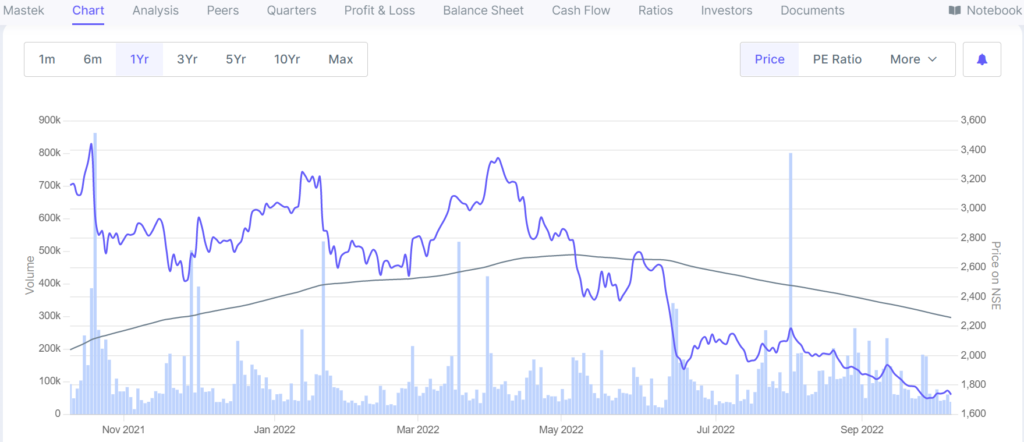
Part 2: Current PE for Mastek is 17.1, and 5 historical media PE is 15.5. Part 2 of the rule is not cleared, as current PE is more than five year median PE.
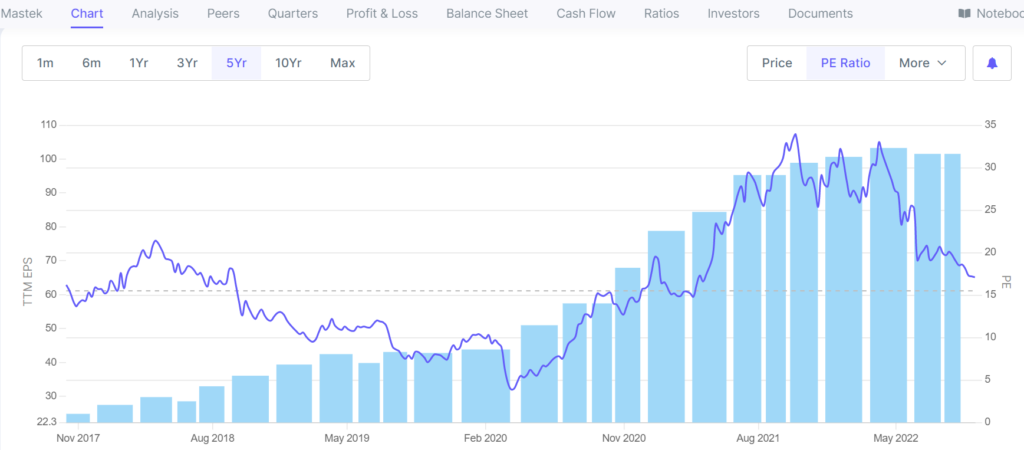
This means that Mastek is not currently available at a fair price, hence investors should wait for further correction in the stock price to buy Mastek.
Golden Rule analysis w.r.t. Mastek
We see that Mastek stock price has been falling in 2022, giving 43% negative returns in 2022 year till date. This is caused by correction in the entire Indian IT sector, and ongoing headwinds from recession in the US. Hence, the price of Mastek in 2021 was hugely overvalued, with PE becoming twice of the 5 year median PE. Buying Mastek in 2021 would be buying it at an expensive valuation, and then seeing your investment reduced by half in 2022 after correction. This points out to the usefulness of the golden rule in picking the right price to invest in.
Can Mastek PE rerate upward?
Mastek’s historical median PE (15.5) is lower than Industry average PE (29). Hence there is a scope for Mastek’s PE to re-rate upward. Mastek gets a lower PE due to revenue concentration from one single client – the UK government – which contributes to > 60% of Mastek’s revenue.
Mastek has acquired key companies in the past two years, including Evosys (US focused Oracle cloud service provider), MST Solutions (US focused Salesforce service provider). With these two acquisitions shaping up in coming years, Mastek will be able to diversify out of the UK, and into new cloud service providers. This can help in up-rating of Mastek by 2025, as compared to other mid-cap IT peers such as Mphasis and Persistent Systems.
In summary, I would still use the golden rule for Mastek. I would give an upward margin of error of 3-5% to take a buy call for Mastek. I believe that there is a strong case for Mastek to re-rate upwards. Hence its historical median PE may rise going forward in the next 1 year.
4.2 Reliance Industries (NSE: RELIANCE)

Reliance Industries is a Oil to Chemical conglomerate. It has been making inroads into new age businesses, such as Telecom via Reliance Jio, and Grocery business via Reliance JioMart. Let’s apply the golden rule to Reliance.
Part 1: Reliance CMP is INR 2,342, which is less than 200 DMA of INR 2,490. Hence part 1 of the golden rule is cleared.
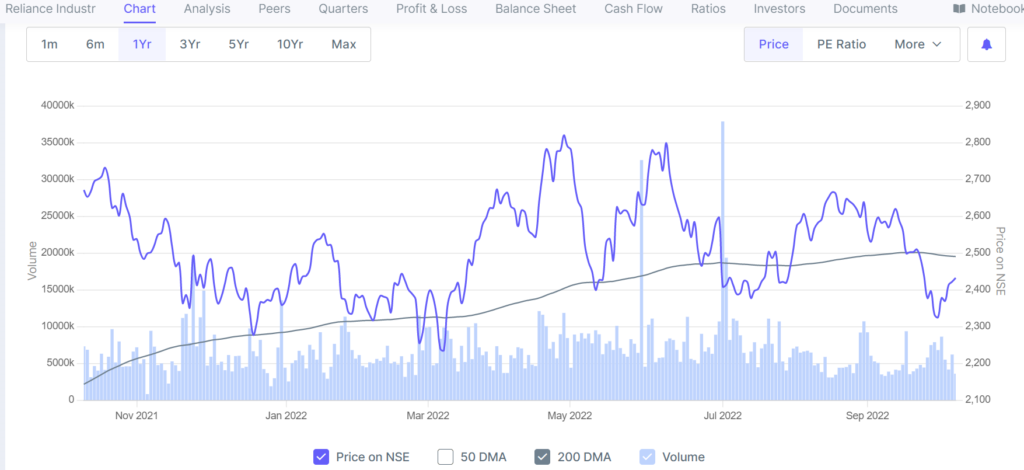
Part 2: Reliance current PE is 24.7, which matches the 5 year median PE of 24.6, hence part 2 of the golden rule is also cleared.
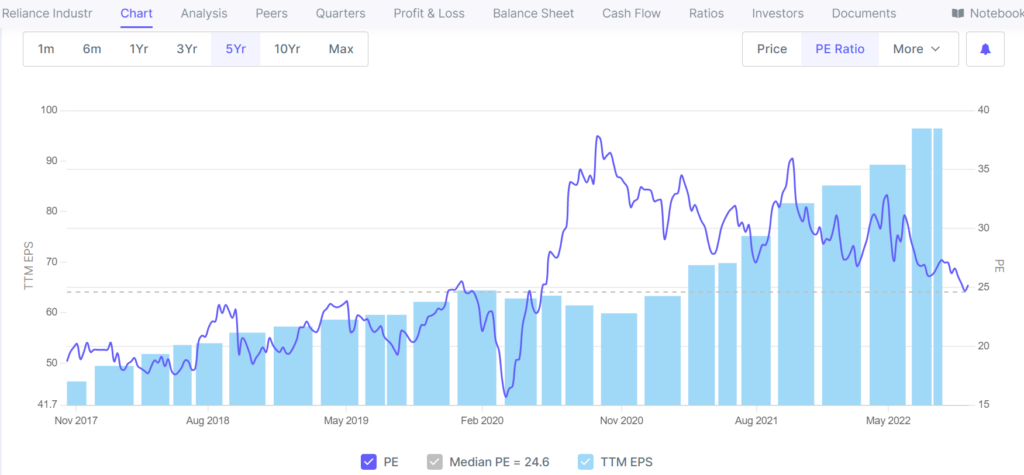
As per the Golden Rule, Reliance is in a buy zone, and is available at an attractive price. Retail investors can consider buying Reliance at the current market price of INR 2,342.
Can Reliance’s PE re-rate upwards?
Short answer is – Yes. Reliance’s new age businesses of telecom and groceries can help in upwards rating of the PE. However, these new businesses are small as compared to the traditional business of Oil to Chemical. It will take time, at least 5 years from now, to see a sustained PE re-rating for Reliance Industries. Till that time, a PE of 25 or lower can be called a buy zone for Reliance Industries.
4.3 Axis Bank (NSE: AXISBANK)

Axis Bank is the fourth largest private sector bank in India. It provides a wide range of banking services to individuals and corporations. Let us find out if Axis Bank is in a buy zone in September 2022.
Part 1: CMP of Axis Bank is INR 755, which is higher than 200 DMA of INR 725. Hence, Axis Bank does not clear part 1 of the golden rule, and is trading higher than its 200 days moving average price.
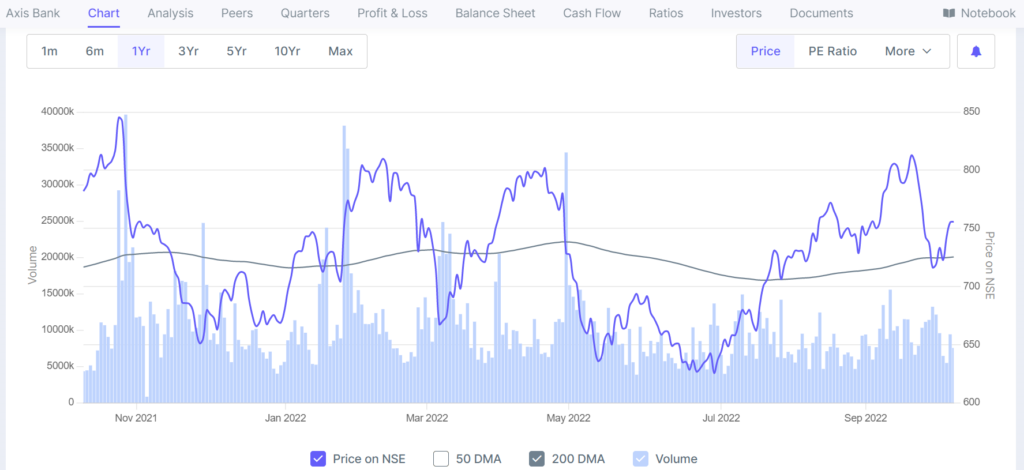
Part 2: Current PE of Axis Bank is 14, which is much less than its 5 year median PE of 32. Axis Bank clears part 2 of the golden rule, and is trading at a much lower PE than its historical average.
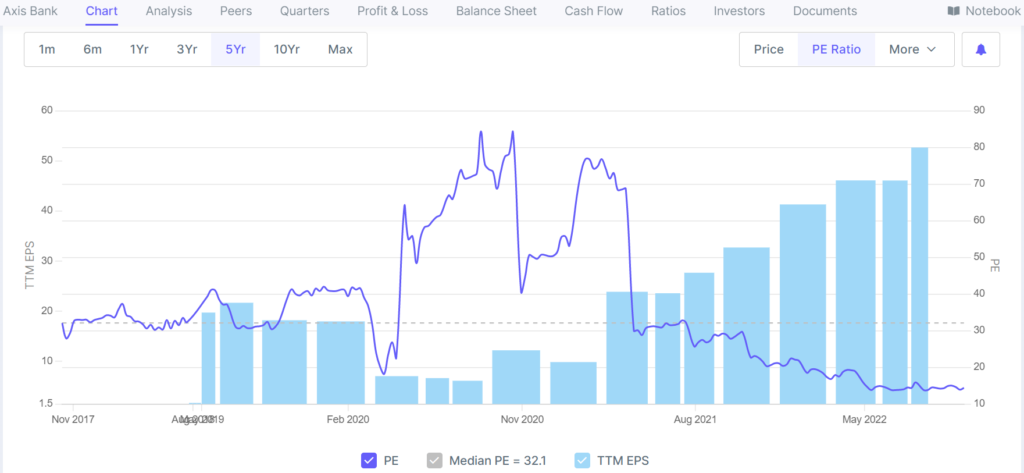
Conclusion: As per the golden rule, Axis Bank is very close to its buy zone price, as it is trading at cheaper valuation when compared to historical 5 year valuation (PE). I would put a GTT buy order on Axis bank at its 200 DMA price of INR 725.
Golden Rule analysis of Axis Bank
Axis Bank is coming out of a downcycle for the entire banking sector. This results in 200 DMA being always lower than CMP. Hence Part 1 of the golden rule may not always apply. The takeaway from Axis Bank analysis is that Part 1 of the golden rule may not be valid for a company re-surfacing from a multiple year down cycle. This makes the stock’s CMP higher than 200 DMA, even if its current PE is trading at a discount when compared with 5 year median PE.
4.4 Ambuja Cement (NSE: AMBUJACEM)

Ambuja cement is one of the top cement players in India. It is an age-old brand, and well recognized across India. It is a dominant player in the north region of India, with minor presence in West and East India as well.
Part 1: CMP of Ambuja Cements is INR 521, which is higher than 200 DMA of INR 395. Hence, Ambuja Cements does not clear the part 1 of the golden rule, as it is trading at a much higher price than 200 DMA.
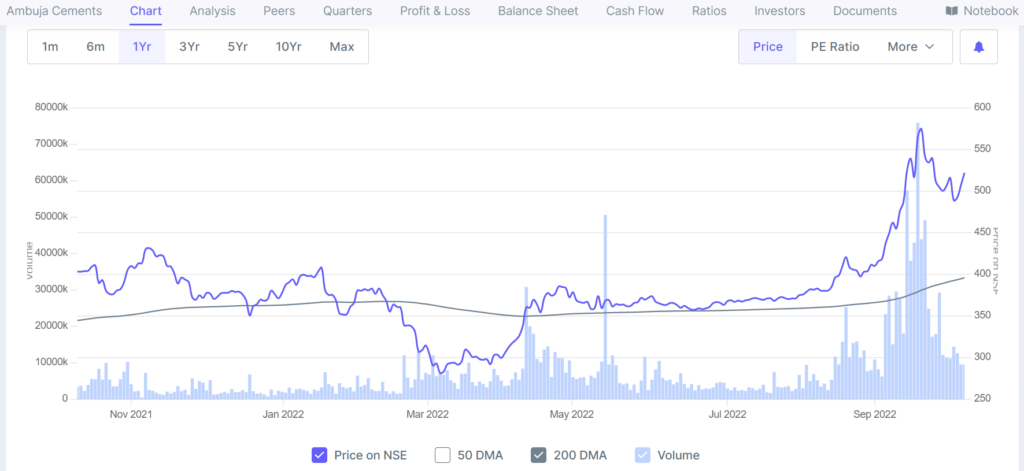
Part 2: Current PE of Ambuja Cements is 43, which is much higher than 5 year median PE of 23.6. Hence Ambuja Cements does not clear part 2 of the golden rule.
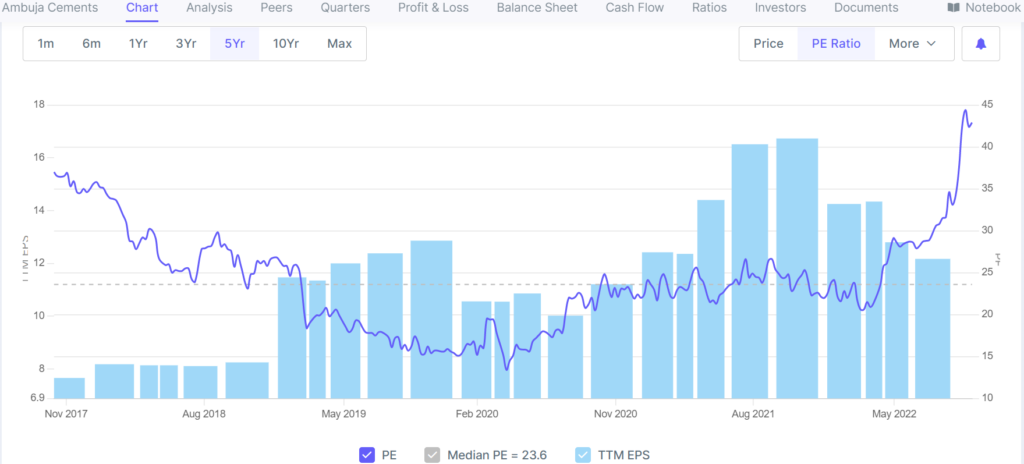
Conclusion: Ambuja Cements is trading at a pricey valuation, and is far away from a buy zone. Some reasons for higher valuation can be the recent acquisition of Ambuja Cements by Adani group. With an aggressive promoter group at its helm, Ambuja Cements is expected to expand its capacity in the coming years. This will in turn lead to higher than historical average revenue growth for the company. As for me, I will stay away from investing in such expensive companies.
In this section, we see that the golden rule works well when both parts of the rule give the same signal. That is, when both part 1 and part 2 of the rule are not cleared, it is a NOT BUY call for the stock. If both part 1 and part 2 of the rule are cleared, it is a BUY call on the stock.
However, if Part 1 is not cleared, and Part 2 is cleared, check if the company is coming out of a multi-year downcycle. If yes, you can still consider investing in this stock, else not. If Part 1 is cleared, but part 2 is not cleared, check if the company is re-rating upward driven by acquisitions, entry into a sunrise sector etc. If yes, you can consider investing in the stock, else not.
5. Exceptions to the golden rule
In section 4, we looked at some exceptions to the golden rule, when part 1 and part 2 of the rule give opposite signals. In this section, I will lay down exceptions to the golden rule you should keep in mind while taking investing decision.
5.1 Company entering into a downcycle

Even if the golden rule tells that the stock price is in the Buy zone, there can be situations when further downside in stock price is possible. This can be caused by macroeconomic headwinds in the industry sector the company operates, such as demand/supply disruption, regulatory changes etc. Another reason can be the start of an industry downcycle, when valuations of the companies in this sector will become cheaper with time, as the downcycle plays out. If you are a long term investor, then headwinds in the short term should be considered as buying opportunities. During downcycles, you can average out your investments by buying more as price falls further, given the long term growth story of the company remains intact.
5.2 Company emerging from a downcycle

This situation is the reverse of the one discussed in section 5.1 above. In this case, a company is emerging out of a multi-year downcycle. Hence, part 1 of the golden rule may not be cleared (CMP < 200 DMA), even when part 2 of the rule is cleared (Current PE <= 5 year median PE). The reason is that the stock price will keep on increasing, as the company enters an upcycle. A company entering into an upcycle shows an increase in revenue and visible future growth trajectory. In this situation, one should consider investing in the company, or put a GTT order nearer to +5% of 200 DMA.
5.3 PE Uprating
In the golden rule, there can be situations when Part 1 of the rule is fulfilled (CPM < 200 DMA), but the second part of the rule is not fulfilled (PE <= Historical Median PE). In these situations, an investor should check if the company’s PE is undergoing re-rating upwards. PE up-rating can be driven by the company’s future growth strategy, acquisitions etc.
An example we encountered in section 4 is Mastek, and Reliance, where possibility of PE up-rating is possible. However, you should analyze PE uprating for a longer time period, usually more than 1 year. This is because in the short run, PE can be volatile as well.
5.4 PE Downrating
Opposite of 5.3, there can be a PE downrating of a stock. This can happen if the company is facing stiff competition, or the company is unable to adapt to new technology to remain relevant. Example: Muthoot Finance – is a gold loan company targeting unbanked Indian population. However, Muthoot Finance is unable, and slightly unwilling, to adopt technology to target internet savvy consumers. Hence, its growth rate will decrease in future, leading to PE downrating for this company.
It is important to first select a good company, with good future growth prospects, as laid down in section 3.3 of this post. Once you have researched a good company to invest in, you can apply the golden rule to find whether the current price of the stock is fairly valued or not.
6. Parting Thoughts
The golden rule for picking the right price to invest in a fundamentally good stock works most of the time. I have found this rule useful in the investment decisions I have taken. This rule helps me set the correct Limit or GTT order on a stock, or take a buy decision right away if the stock is in Buy zone as indicated by the rule.
The other good thing about the rule is its simplicity. You can apply this rule in less than a minute. All stock screeners offer free stock price/PE charts to help apply this rule. I prefer to use screener.in, where these charts are easily available on the stock information page itself. Do note that there are more complex, and accurate indicators for fairly valued stock. Example: DCF method, or RSI/MACD indicators. However, the golden rule laid down in this post will help you 90% of the time. This should be good enough for a retail investor. If you take care of the exceptions I mentioned in section 5, then the golden rule + exceptions may actually cover all investment decision scenarios.
I hope this post helped you to acquire a new trick up your investment sleeve. Or at least triggered your mind to think of quick price valuation indicators 🙂 .
Which stock did you analyze using this rule, and what was the outcome?
Share in the comments below.
Happy Investing !





Pingback: Buy the Dip Vs Avoid Catching a Falling Knife Investment Approach - Mayank Dwivedi